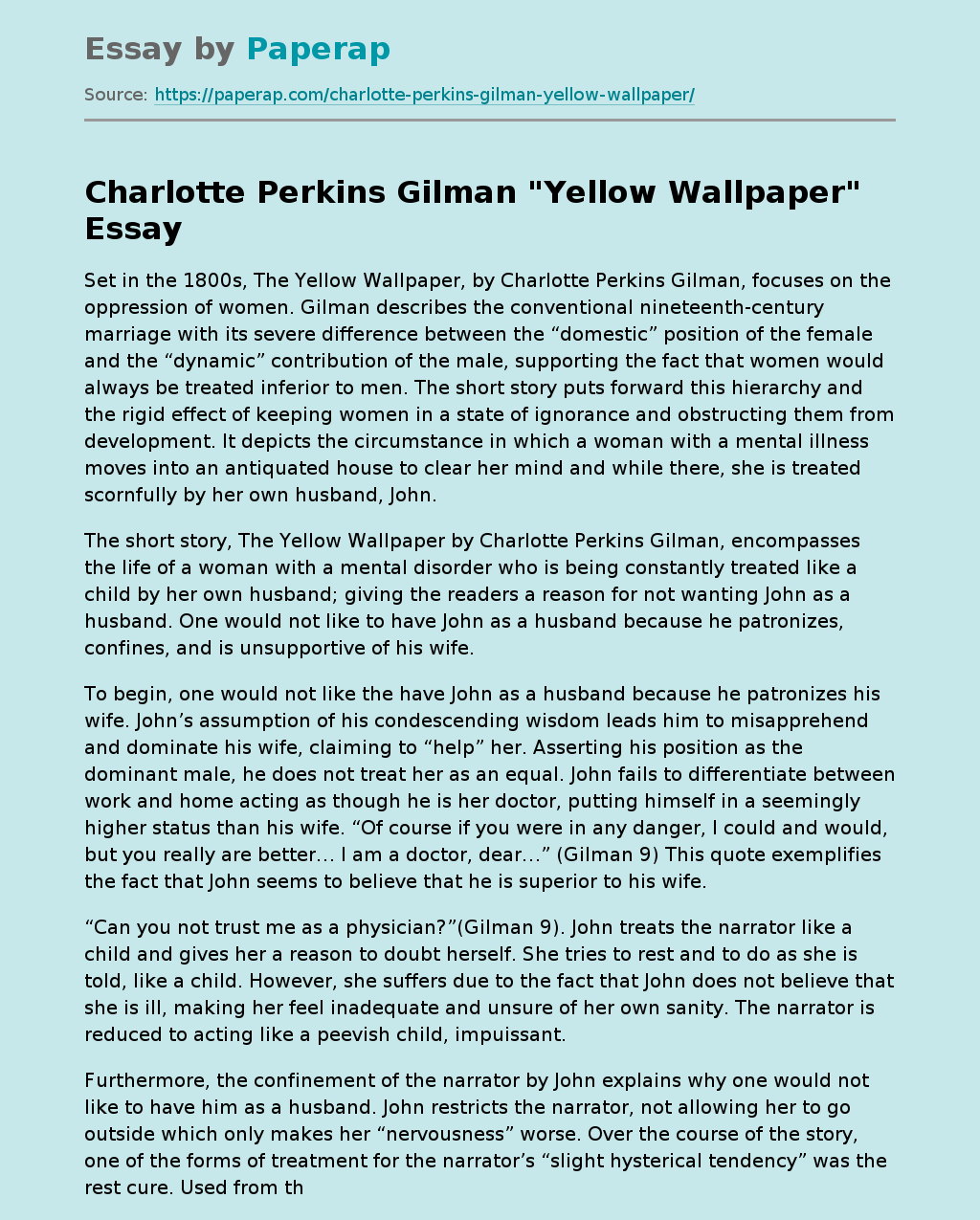Charlotte Perkins Gilman "Yellow Wallpaper"
Set in the 1800s, The Yellow Wallpaper, by Charlotte Perkins Gilman, focuses on the oppression of women. Gilman describes the conventional nineteenth-century marriage with its severe difference between the “domestic” position of the female and the “dynamic” contribution of the male, supporting the fact that women would always be treated inferior to men. The short story puts forward this hierarchy and the rigid effect of keeping women in a state of ignorance and obstructing them from development. It depicts the circumstance in which a woman with a mental illness moves into an antiquated house to clear her mind and while there, she is treated scornfully by her own husband, John.
The short story, The Yellow Wallpaper by Charlotte Perkins Gilman, encompasses the life of a woman with a mental disorder who is being constantly treated like a child by her own husband; giving the readers a reason for not wanting John as a husband. One would not like to have John as a husband because he patronizes, confines, and is unsupportive of his wife.
To begin, one would not like the have John as a husband because he patronizes his wife. John’s assumption of his condescending wisdom leads him to misapprehend and dominate his wife, claiming to “help” her. Asserting his position as the dominant male, he does not treat her as an equal. John fails to differentiate between work and home acting as though he is her doctor, putting himself in a seemingly higher status than his wife. “Of course if you were in any danger, I could and would, but you really are better… I am a doctor, dear…” (Gilman 9) This quote exemplifies the fact that John seems to believe that he is superior to his wife.
“Can you not trust me as a physician?”(Gilman 9). John treats the narrator like a child and gives her a reason to doubt herself. She tries to rest and to do as she is told, like a child. However, she suffers due to the fact that John does not believe that she is ill, making her feel inadequate and unsure of her own sanity. The narrator is reduced to acting like a peevish child, impuissant.
Furthermore, the confinement of the narrator by John explains why one would not like to have him as a husband. John restricts the narrator, not allowing her to go outside which only makes her “nervousness” worse. Over the course of the story, one of the forms of treatment for the narrator’s “slight hysterical tendency” was the rest cure. Used from the late nineteenth century to the early twentieth, this “cure” largely confined women to their beds.
They were forbidden to have social interactions which is largely seen throughout the entirety of the story. John is a caretaker and doctor to the story’s narrator, so his role as someone who confines and constrains her psychologically and physically is reinforced multiple times. The narrator is confined, leading her to hallucinate and obsess over a wallpaper in which she believes a woman is stuck in. He fails to understand that the wallpaper is a symbolic prison. John begins to neglect her, exacerbating her “condition.” Moreover, one would not like have John as a husband because he is unsupportive of his wife.
“There comes John, and I must put this away – he hates to have me write a word.” (Gilman 3). This quote shows that he suppresses her writing one the ways that she can express herself. It is for sure the narrator suffers from postpartum depression, however, John’s condescension and manipulations aggravate her condition. Truly, he does not take her condition seriously, laughing at her imagination and fancies. It is seen when the narrator says, “He says no one but myself can help me out of it, that I must use my will and self-control and not let and fancies run away with me. Sadly, what John does not realize is that his wife is imaginative by nature and is not allowing to let her imagination run wild, showing his unsupportiveness.
John laughs at his wife for using her imagination and her obsession over the wallpaper. Rather than listen to her wifes complaints about the wallpaper, he says the house is making her better. John refuses to understand the creative theories about the country house, not supporting her beliefs and ideas. In conclusion, one would not like John as a husband because he patronizes, confines, and is unsupportive of his wife. All of these fall under women’s oppression and how they were restricted at the time. At the end of The Yellow Wallpaper, due to the way that her husband treats her and disrespects her, the super- mentally ill narrator strips off the wallpaper in her room and creeps around when her husband shows up at the door.
She tells him that she is free and that she has liberated herself. He faints, and she continues to creep around the room. All of this is due to the way that her husband treats her and how he continues to worsen her “condition.” Ultimately, the narrator finds freedom from her husband as she just ignores his presences to go her own way. Despite the fact that the narrator is now completely insane, you can see her crawling over her husband as a moment of power for her, and ultimately all women. She is physically and metaphorically moving past her husband, her societal restrictions.
Charlotte Perkins Gilman "Yellow Wallpaper". (2021, Dec 11). Retrieved from https://paperap.com/charlotte-perkins-gilman-yellow-wallpaper/

